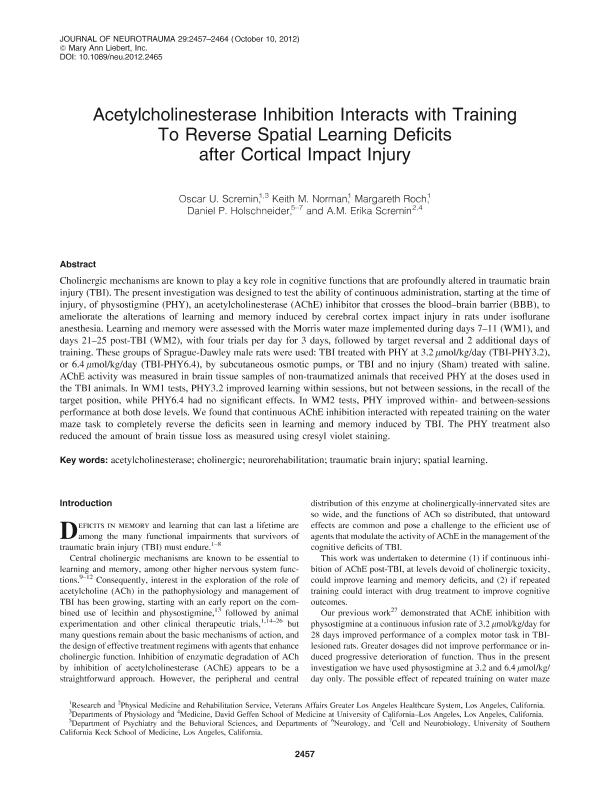Mostrar el registro sencillo del ítem
dc.contributor.author
Scremin, Oscar Umberto

dc.contributor.author
Norman, Keith M.
dc.contributor.author
Roch, Margareth
dc.contributor.author
Holschneider, Daniel P.
dc.contributor.author
Scremin, A. M. Erika
dc.date.available
2023-05-15T14:56:46Z
dc.date.issued
2012-10
dc.identifier.citation
Scremin, Oscar Umberto; Norman, Keith M.; Roch, Margareth; Holschneider, Daniel P.; Scremin, A. M. Erika; Acetylcholinesterase inhibition interacts with training to reverse spatial learning deficits after cortical impact injury; Mary Ann Liebert; Journal of Neurotrauma; 29; 15; 10-2012; 2457-2464
dc.identifier.issn
0897-7151
dc.identifier.uri
http://hdl.handle.net/11336/197514
dc.description.abstract
Cholinergic mechanisms are known to play a key role in cognitive functions that are profoundly altered in traumatic brain injury (TBI). The present investigation was designed to test the ability of continuous administration, starting at the time of injury, of physostigmine (PHY), an acetylcholinesterase (AChE) inhibitor that crosses the blood-brain barrier (BBB), to ameliorate the alterations of learning and memory induced by cerebral cortex impact injury in rats under isoflurane anesthesia. Learning and memory were assessed with the Morris water maze implemented during days 7-11 (WM1), and days 21-25 post-TBI (WM2), with four trials per day for 3 days, followed by target reversal and 2 additional days of training. These groups of Sprague-Dawley male rats were used: TBI treated with PHY at 3.2 μmol/kg/day (TBI-PHY3.2), or 6.4 μmol/kg/day (TBI-PHY6.4), by subcutaneous osmotic pumps, or TBI and no injury (Sham) treated with saline. AChE activity was measured in brain tissue samples of non-traumatized animals that received PHY at the doses used in the TBI animals. In WM1 tests, PHY3.2 improved learning within sessions, but not between sessions, in the recall of the target position, while PHY6.4 had no significant effects. In WM2 tests, PHY improved within- and between-sessions performance at both dose levels. We found that continuous AChE inhibition interacted with repeated training on the water maze task to completely reverse the deficits seen in learning and memory induced by TBI. The PHY treatment also reduced the amount of brain tissue loss as measured using cresyl violet staining.
dc.format
application/pdf
dc.language.iso
eng
dc.publisher
Mary Ann Liebert

dc.rights
info:eu-repo/semantics/openAccess
dc.rights.uri
https://creativecommons.org/licenses/by-nc-sa/2.5/ar/
dc.subject
ACETYLCHOLINESTERASE
dc.subject
CHOLINERGIC
dc.subject
NEUROREHABILITATION
dc.subject
SPATIAL LEARNING
dc.subject
TRAUMATIC BRAIN INJURY
dc.subject.classification
Otros Tópicos Biológicos

dc.subject.classification
Ciencias Biológicas

dc.subject.classification
CIENCIAS NATURALES Y EXACTAS

dc.title
Acetylcholinesterase inhibition interacts with training to reverse spatial learning deficits after cortical impact injury
dc.type
info:eu-repo/semantics/article
dc.type
info:ar-repo/semantics/artículo
dc.type
info:eu-repo/semantics/publishedVersion
dc.date.updated
2023-05-12T16:46:15Z
dc.journal.volume
29
dc.journal.number
15
dc.journal.pagination
2457-2464
dc.journal.pais
Estados Unidos

dc.journal.ciudad
New York
dc.description.fil
Fil: Scremin, Oscar Umberto. University of California at Los Angeles. School of Medicine; Estados Unidos. Consejo Nacional de Investigaciones Científicas y Técnicas. Centro Científico Tecnológico Conicet - Rosario; Argentina
dc.description.fil
Fil: Norman, Keith M.. No especifíca;
dc.description.fil
Fil: Roch, Margareth. No especifíca;
dc.description.fil
Fil: Holschneider, Daniel P.. No especifíca;
dc.description.fil
Fil: Scremin, A. M. Erika. University of California at Los Angeles. School of Medicine; Estados Unidos
dc.journal.title
Journal of Neurotrauma

dc.relation.alternativeid
info:eu-repo/semantics/altIdentifier/url/https://www.liebertpub.com/doi/10.1089/neu.2012.2465
dc.relation.alternativeid
info:eu-repo/semantics/altIdentifier/doi/http://dx.doi.org/10.1089/neu.2012.2465
Archivos asociados
